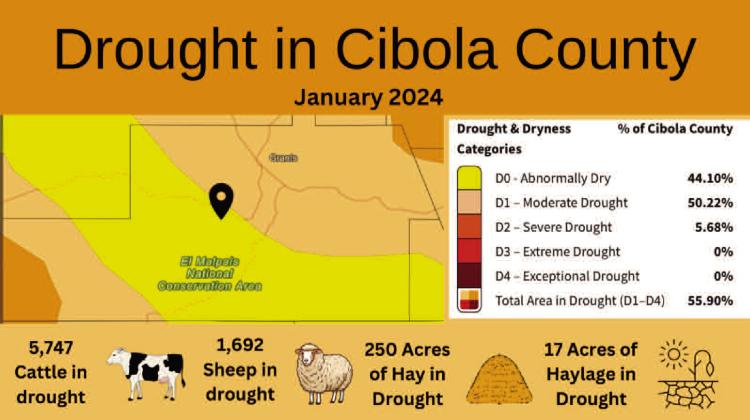Diego Lopez, Reporter
CIBOLA COUNTY Experiencing its 19th wettest January on record, the drought situation in Cibola has worsened slightly through the county since December, but less livestock are effected by bad drought than in December.
Drought Across Cibola in December
The U.S. Drought Monitor classifies the severity of drought using five categories, ranging from the least severe designation, 'Abnormally Dry' (D0), to the most severe, 'Exceptional Drought' (D4).
• Abnormally Dry (D0) 44.10 percent of Cibola is affected, a large swath of and from the northwest that cuts to the southeast, expanding from east of Fence Lake to through the Pueblo of Laguna to the east. This is less than December when 43.73 percent of the county was affected.
• Moderate Drought (D1) – 50.22 percent of Cibola is affected. This is higher than December, where 45.62 percent of the county was affected.
• Severe Drought (D2) – 5.68 percent of the county is affected/ This is a large area in the west where Cibola borders Arizona, the Zuni Pueblo area, ending before Fence Lake. This is significantly lower than in December, when 10.65 percent of the county was affected by D2 drought.
• Extreme Drought (D3) No areas recorded. This was the same in December.
• Exceptional Drought (D4) - No areas recorded. This was the same in December.
Through January, 250 acres of hay were found to be in drought, along with 17 acres of haylage. This is less than December, which showed 252 acres of hay and 17 acres of haylage were in drought.
Effecting livestock, 5,747 cattle and 1,692 sheep were found to be in drought during this January. This is less livestock than in December, when 5, 785 cattle were in drought, and 1,703 sheep were in drought, showing minor improvements for Cibola’s livestock.
In January, Cibola experienced an increase in drought coverage, with 55.9 percent of its area affected. This marks a rise of 1.2 percent compared to the previous month. Through December, 55.62 percent of Cibola County’s total area was in drought.
“Exceptional Drought” Tracking
“Exceptional Drought” is the worst level of drought Cibola could be designated. Currently, there is not a piece of land in the county that is affected by “Exceptional Drought.”
2013 was the first time Cibola entered the “exceptional” category, the rating lasted for several months before ending.
While the county remained in drought, it was not given the “exceptional” rating again until 2020. The rating was assigned in December, and persisted through most of 2021.
May of 2022 saw the worst “Exceptional Drought” in county history. The United States Drought Monitor tracks the severity and length of drought across the country. The severity of 2022’s “Exceptional Drought” was starkly worse than either of the previous two times this rating was assigned to Cibola. However, 2022’s situation lasted for a shorter amount of time than either of the previous two instances.
In 2022, Cibola suffered through the driest May over the past 300 years of drought tracking in the county, the area was suffering so badly that scientists who conduct drought tracking declared Cibola was in an “Exceptional Drought” the worst level of drought recognized by the federal government.
In June 2022, a large wildfire, the Cerro Bandera Fire, destroyed 939 acres of land in the Zuni Mountains. Fire personnel in Cibola rallied together after the fire, asking for increased fire restrictions through the month of June, especially because the Independence Day holiday was rapidly approaching and residents often celebrate with fireworks. At the time, the drought rating in Cibola was at the highest rating recognized by federal authorities who track drought across the country. Increased rainfall at the end of June, continued through August, was enough for local governments to lift some firework and open burning restrictions. Rainfall, despite expectations by meteorologists, did not stop fully but has decreased from earlier months. Cibola’s drought conditions have improved measurably since the driest days of 2022.
The last time Cibola entered Exceptional Drought was in the middle of May 2023. The drought hit its peak at the middle of June, reaching the point where 40 percent of the county was impacted by this drought. This spell lasted about a month, ending near the end of June
Drought Data
The National Integrated Drought Information System is a tool used by the National Oceanic and Atmospheric Administration; a department of the United States known by many as the team who tracks Santa Claus during the Christmas holiday. NIDIS has been tracking drought in the Cibola area since 2006, and they use other historic data and environmental sampling to get a drought reading on years prior, all the way up to 1894 – that’s 300 years of data.
Much of the data Cibola Citizen utilizes comes from NIDIS, but also NOAA and the US Department of Agriculture and the National Agricultural Statistics Service. These entities supply data for Cibola’s acreage of hay and number of livestock.

